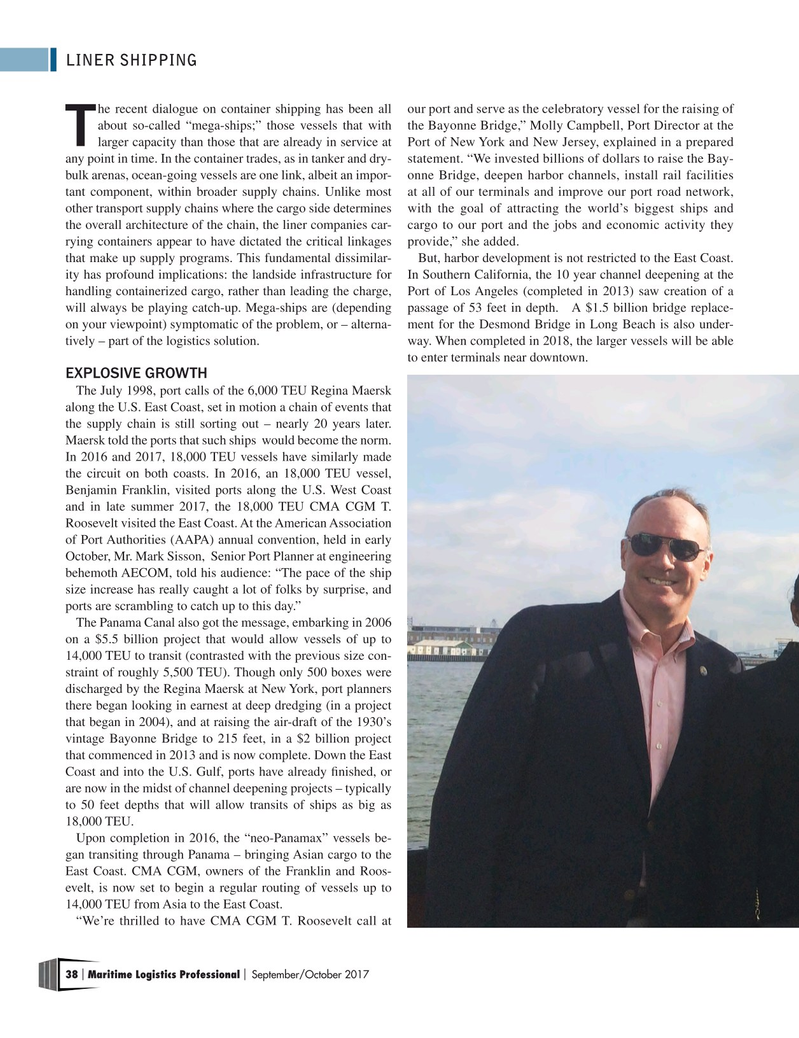
Page 38: of Maritime Logistics Professional Magazine (Sep/Oct 2017)
CONTAINER PORTS
Read this page in Pdf, Flash or Html5 edition of Sep/Oct 2017 Maritime Logistics Professional Magazine
LINER SHIPPING he recent dialogue on container shipping has been all our port and serve as the celebratory vessel for the raising of about so-called “mega-ships;” those vessels that with the Bayonne Bridge,” Molly Campbell, Port Director at the
T larger capacity than those that are already in service at Port of New York and New Jersey, explained in a prepared any point in time. In the container trades, as in tanker and dry- statement. “We invested billions of dollars to raise the Bay- bulk arenas, ocean-going vessels are one link, albeit an impor- onne Bridge, deepen harbor channels, install rail facilities tant component, within broader supply chains. Unlike most at all of our terminals and improve our port road network, other transport supply chains where the cargo side determines with the goal of attracting the world’s biggest ships and the overall architecture of the chain, the liner companies car- cargo to our port and the jobs and economic activity they rying containers appear to have dictated the critical linkages provide,” she added. that make up supply programs. This fundamental dissimilar- But, harbor development is not restricted to the East Coast. ity has profound implications: the landside infrastructure for In Southern California, the 10 year channel deepening at the handling containerized cargo, rather than leading the charge, Port of Los Angeles (completed in 2013) saw creation of a will always be playing catch-up. Mega-ships are (depending passage of 53 feet in depth. A $1.5 billion bridge replace- on your viewpoint) symptomatic of the problem, or – alterna- ment for the Desmond Bridge in Long Beach is also under- tively – part of the logistics solution. way. When completed in 2018, the larger vessels will be able to enter terminals near downtown.
EXPLOSIVE GROWTH
The July 1998, port calls of the 6,000 TEU Regina Maersk along the U.S. East Coast, set in motion a chain of events that the supply chain is still sorting out – nearly 20 years later.
Maersk told the ports that such ships would become the norm.
In 2016 and 2017, 18,000 TEU vessels have similarly made the circuit on both coasts. In 2016, an 18,000 TEU vessel,
Benjamin Franklin, visited ports along the U.S. West Coast and in late summer 2017, the 18,000 TEU CMA CGM T.
Roosevelt visited the East Coast. At the American Association of Port Authorities (AAPA) annual convention, held in early
October, Mr. Mark Sisson, Senior Port Planner at engineering behemoth AECOM, told his audience: “The pace of the ship size increase has really caught a lot of folks by surprise, and ports are scrambling to catch up to this day.”
The Panama Canal also got the message, embarking in 2006 on a $5.5 billion project that would allow vessels of up to 14,000 TEU to transit (contrasted with the previous size con- straint of roughly 5,500 TEU). Though only 500 boxes were discharged by the Regina Maersk at New York, port planners there began looking in earnest at deep dredging (in a project that began in 2004), and at raising the air-draft of the 1930’s vintage Bayonne Bridge to 215 feet, in a $2 billion project that commenced in 2013 and is now complete. Down the East
Coast and into the U.S. Gulf, ports have already fnished, or are now in the midst of channel deepening projects – typically to 50 feet depths that will allow transits of ships as big as 18,000 TEU.
Upon completion in 2016, the “neo-Panamax” vessels be- gan transiting through Panama – bringing Asian cargo to the
East Coast. CMA CGM, owners of the Franklin and Roos- evelt, is now set to begin a regular routing of vessels up to 14,000 TEU from Asia to the East Coast. “We’re thrilled to have CMA CGM T. Roosevelt call at 38 Maritime Logistics Professional September/October 2017 | |

 37
37

 39
39
